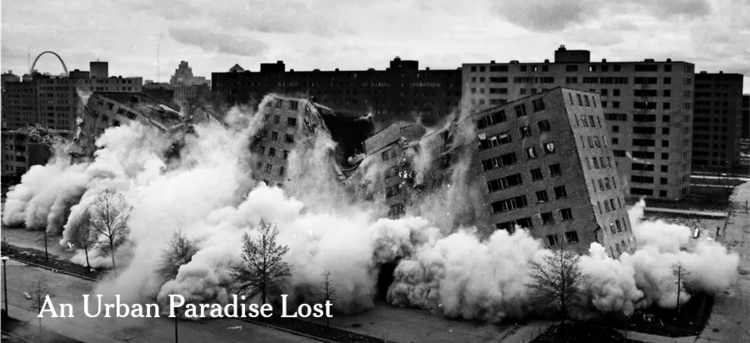


By Steve Sailer
01/28/2012
Among many writers on architecture others, Tom Wolfe gleefully celebrated the 1972 demolition of the Pruitt-Igoe housing project in St. Louis as one in the eye for the modernist style of architecture that he disliked. But a New York Times critic notes that, hey, wait a minute, there are a lot of Le Corbusier-style apartment towers still around that aren’t vertical hellholes. What gives?
Tower of Dreams: One Ended in Nightmare
Michael Kimmelman
I went to Penn South this week, having seen “The Pruitt-Igoe Myth,” Chad Freidrichs’s shattering documentary, now at the IFC Center. Pruitt-Igoe was the notorious St. Louis public-housing complex, demolished in 1972. Images of imploded Pruitt-Igoe buildings, broadcast worldwide, came to haunt the American consciousness. Critics of welfare, big government and modern architecture all used the project as a whipping boy. “The day that modern architecture died,” Charles Jencks, the architect and apostle of postmodernism, called the demolition.
Penn South (started a half century ago by the International Ladies Garment Workers Union) is a cooperative in affluent, 21st-century Manhattan past which chic crowds hustle every day to and from nearby Chelsea’s art galleries, apparently oblivious to it. It thrives within a dense, diverse neighborhood of the sort that makes New York special. Pruitt-Igoe, segregated de facto, isolated and impoverished, collapsed along with the industrial city around it.
But they’re both classic examples of modern architecture, the kind Mr. Jencks, among countless others, left for dead: superblocks of brick and concrete high rises scattered across grassy plots, so-called towers in the park, descended from Le Corbusier’s “Radiant City.” The words “housing project” instantly conjure them up.
Alienating, penitential breeding grounds for vandalism and violence: that became the tower in the park’s epitaph. But Penn South, with its stolid redbrick, concrete-slab housing stock, is clearly a safe, successful place. In this case the architecture works. In St. Louis, where the architectural scheme was the same, what killed Pruitt-Igoe was not its bricks and mortar. (Minoru Yamasaki, who designed the World Trade Towers, was the architect.)
The lesson these two sites share has to do with the limits of architecture, socially and economically, never mind what some architects and planners promise or boast. The two projects, aesthetic cousins, are reminders that no typology of design, no matter how passingly fashionable or reviled, guarantees success or failure: neither West Village-style brownstones nor towers in the park nor titanium-clad confections. This is not to say architecture is helpless, only that it is never destiny and that it is always hostage to larger forces.
iSteve readers won’t have too much trouble figuring out why the same architectural style led to different fates in Pruitt-Igoe, which had been the boyhood home of two future heavyweight champs, Leon and Michael Spinks, and Penn South, a private co-op started by a heavily Jewish union for its members. I noticed about 1983 that the modernist high rise I was living in in Chicago was about the same style as the notorious Cabrini Green housing projects.
Most of the comments sounded pretty clueless, but this one was pretty good:
Thank you for this. Too often, we are force-fed the notion that high-rise buildings for the poor and working class was a failed idea of the past that can never work. We are told the only solution to the nation’s housing problems are "mixed-income" low-rise buildings. This has served as a cover for the demolition of thousands of units of affordable housing and subsequent dislocation of the poor (and Federal subsidiziation of middle class in the replacement houses). The replacement low-rise homes in places like Chicago or St. Louis might look better to suburban eyes, but in reality they are a massive waste of taxpayer money — often subsidized to the tune of 2-300k per unit. Properly maintaining the buildings, and making sure services, employment and management of the buildings are there, are much more efficient uses of taxpayer money.
In other words, the current orthodoxy that public housing projects for poor people should be low to the ground less reflects some design theory breakthrough than it does the covert realization that if you don’t stack poor people up high, then you can’t have as many around you. Most of them will have to go somewhere else, far away from you. So, of course, all sensitive, sophisticated Chicagoans now want a handful of handpicked poor people to enjoy lovely lowrise accommodations … because that means that the rest of them have to go live in Champagne-Urbana or Round Lake Beach or somewhere else far away from Chicago.
This is not to say that one need not be careful about the interaction of the types of buildings and the types of residents. For example, my experience at Rice U. was that it was a really bad idea to house 250 young men, especially young engineering majors, in the only high rise on campus.The urge to drop stuff from 14 floors up is a powerful one in the 19-year-old’s mind, especially when all your rivals live in much lower dormitories over which you, possessing the high ground, can easily exert military dominance. It turns out that you can build a giant slingshot out of rubber surgical tubing and shoot water balloons about 300 yards with fair accuracy. You just have four guys stand on the edge of the balcony holding the ends of the surgical tubing, then have have a couple of pullers draw the slingshot back across the big lobby, then call the elevator and pull the water balloon all the way to the back of the elevator, from whence you let it fly.